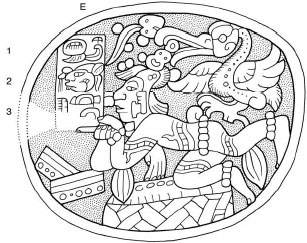Cacao in Ancient Maya Religion (Illustrations)
 The meaning of the conference on K631 is lost to us—although we can imagine a
The meaning of the conference on K631 is lost to us—although we can imagine a
dialogue well known to a contemporary audience.31 In whatever way K’awiil acquires
the precious cacao, the next time we see him he has it as his cargo. A series of painted
capstones that once decorated the vaults of buildings in Campeche, Mexico—most dating
to the eighth or ninth centuries—supply this narrative connection. One of these, now in
the Museo Amparo, Puebla, is particularly explicit (Arrellano 2002:351; Miller and Martin
2004:75) (Figure 8.13a). The bursting bag K’awiil carries has been mistaken for a sack of
maize, but the mention of kakaw “cacao” in the lower glyph-band (here in the underspelling
ka-ka) makes it clear that cacao is the intended subject (Arrellano 2002: 351). A
painted glyph on the bag spells 9-PIK bolon pik for “nine eight-thousands”. This could
describe the unfeasibly large and unworldly quantity of beans it contains (72,000!),
although “nine” is also used as a synonym for “many” in Mayan languages and that is
probably the intention here. In any case, numeration of this kind is typical of the cacao
sacks presented in scenes of tribute payment and is additional evidence that these are the
seeds in question. The text on a second capstone, this one from the site of Dzibilnocac,
mentions an ox wi’il “abundance of food” and lists bread, water, and cacao (here rendered
as ka-wa)—which are shown stacked in plates, sacks, and baskets (Figure 8.13b).
The theme is further amplified on a now-destroyed capstone from the Temple of
the Owls at Chichen Itza (Winning 1985:74-80; Taube 1994a:226-228) (Figure 8.14). Here
we see a winged K’awiil emerging from the mouth of a coiled serpent—a motif that
regularly encapsulates notions of rebirth and transport between worlds. In so doing he
passes through the same crescent-shaped “Jaws of the Underworld” seen on the Palenque
Sarcophagus lid, a motif that also denotes real-life portals in the earth such as the mouths
of caves and cenotes. His destination is the heavens, represented by an enclosing skyband
that emits beams of radiance. In one hand he carries a plate loaded with spherical
beads surmounted by jade earspools.32 Significantly, ripe cacao pods (painted yellow in
the original) hang from both the heavens and Underworld, as if growing naturally from
them.
Updated: Sep 30, 2005 - 18:14
Created: Aug 17, 2005 - 01:21
Download this document in PDF format using the icon. You'll need Adobe Acrobat Reader to view the file. |

File Download
|

